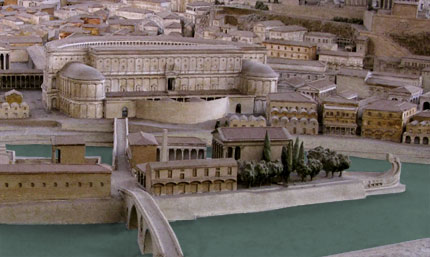As you cross to the right bank of the Tiber over the Pons Fabricius, you leave Tiber Island and enter the Campus Martius, heading for the Theatrum Marcelli. Its travertine marble facade gleams white in the hot sunlight, a jewel in the building program of the Emperor Augustus.

You stroll west, heading for the welcome shade of the covered colonnade that surrounds the building and protects the entryways into the seating area of the theater, the cavea. As you walk, you admire the size and shape of this theater. It seems odd to you that the back of the theater, which features an unusual walled enclosure behind the stage building, the scaena, faces the Tiber, a popular approach. The wall, built perhaps to minimize the flooding of the river, curves around a courtyard the width of the scaena containing two small rectangular structures in the center (thought to be the temples of Pietas and Diana, displaced by the theater), and connects the large roofed apsidal halls flanking it on either side (see reconstruction). Looking to your left you admire the graceful Porticus of Octavia; before you stand the elegant columns of the Temple of Apollo Sosianus, Augustus' patron deity; lifting your eyes you can see the Capitolium, home of the great god Jupiter. It becomes clear why the theater faces in this direction, toward the center of the city.
By the end of the first century BCE Rome had three permanent stone theaters. Set in the Campus Martius, they were of different sizes and were probably intended for different types of ludi (spectacles). The largest was built by Pompey the Great in 55 BCE (see Theatre of Pompey Project). The other two, the theaters of Marcellus and Balbus, were built under the auspices of the Emperor Augustus and were dedicated in the same year, 13 BCE. In his Res Gestae, Appendix 2-3 Augustus claims among his other notable achievements on behalf of the city and people of Rome his building of the Theater of Marcellus and his refurbishment of the Theater of Pompey (see also the image of the Monumentum Ancyranum, the tablets on which the text of this work survived in Turkey, and Suetonius, Vita Augusti 101).
Click on the statue of Marcellus below to learn about the young man whose early death inspired his uncle to build and name this magnificent theater. Click on the scroll below for a brief building history of this theater.